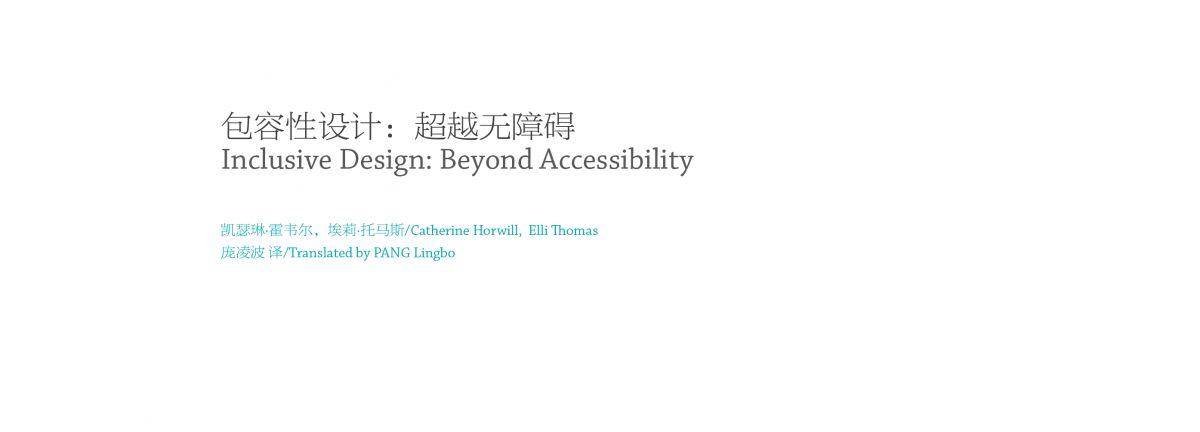Inclusive Design: Beyond Accessibility

Catherine Horwill and Elli Thomas from Design Council's Architecture and Built Environment team were asked to contribute to a special edition of World Architecture Magazine China - 'Accessibility for All'. Catherine and Elli built upon lessons within Design Council's Inclusive Environment programme, identifying the difference between inclusive design and accessibility, the reasons why we champion it, and some of the barriers and routes to enabling a stronger culture around inclusive design. Excerpts from the article can be found below and a link to our Inclusive Environment programme here.
What does it mean to feel excluded?
Imagine for a moment you use a wheelchair. You try to take the train to work – but the lift at the train station hasn't been maintained and you can't access the platform. You ask for help but there aren't any staff available at the station, so you call a taxi instead. It costs you 5 times the price of the train fare, and you're late for work. For one in 10 people in the UK, who have a mobility impairment, that could be an everyday experience.
Then imagine you have an anxiety disorder. Again, you try to take the train to work – but the platforms are overloaded and there's a crush on the train. It's too overwhelming to deal with, so you turn around and go home. You don't go to work that day. For one in 25 people in the UK, who have a mental health impairment, that's another everyday experience.
And now imagine you are a woman. This time, on the way home from work, the platform at the station and the street to your house aren't lit, there are no people around, and there are no houses or shops that overlook the street. You feel threatened and scared – so you divert your route, hold your breath, and only release it once you get inside your house and close the door. For one in 2 people in the UK, that's another everyday experience.
What do these anecdotes show us?
The first example of the wheelchair user shows just one of the any barriers that those with physical disabilities face in using the built environment. But it's easy to be focussed on 'disability' in the built environment and by that we usually mean those with permanent physical disabilities. The second example shows how a non-visible disability can affect our ability to use the built environment in other ways, particularly in ways that we don't always think about either as users or as designers. And the third starts to show how people can be excluded from spaces that are not welcoming, safe or designed for them – and that can be because of our gender, age, sexuality or other characteristics. And we all experience difference – not only do we all get old, or injure ourselves, we also all experience the city differently because of our sexuality, gender, race, whether we have children, and so on. We need to widen our understanding of what this difference is and how we can take it into account to reduce the experience of difference.
Inclusive design goes beyond providing physical access and creates solutions that work better for everyone; ensuring that everyone can equally, confidently and independently use buildings, transport and public spaces. An inclusive environment is one which can be used safely, easily and with dignity by all. It is convenient and welcoming with no disabling barriers, and provides independent access without additional undue effort, separation or special treatment for any group of people.
For the building industry, achieving this is no small feat. It requires a significant systematic and cultural shift. This type of change is best achieved through leadership from the top and commitment and change from the bottom, which collectively help to put in place the framework and formal mechanisms necessary to guide industry as well as develop practitioners' understanding and skillset, whilst also highlighting best practice.
Inclusive design in its broadest sense goes beyond a single building or space. It is a design approach that can address major societal issues such as disadvantage, health and well-being and economic resilience. The built environment is the framework in which people work, socialise and access services. If it is not properly considered, it has the potential to exacerbate inequality by reducing people's access to jobs, social networks and health services through unnecessary barriers such as poor transport connectivity, housing shortages and disconnected social infrastructure. When inclusive design is considered well, our built environment can uplift a society by reducing inequalities and enabling a wider group of people to participate.
Creating an environment which allows more people to participate actively in the economy makes good economic sense. And in the UK, where there are 13.3 million disabled people, the combined spending power of disabled people and their network of friends, family and colleagues is £249 billion. It makes good financial sense to businesses and organisations to ensure that disabled people can use and access their services. And it's not just about being the right thing to do, or about the economic sense – it's about our health, too. Physical inactivity is responsible for one in six UK deaths and behaviour patterns are responsible for 40% of the cause of premature death in the UK. A growing body of evidence is demonstrating how the design of buildings, streets, parks and neighbourhoods can support good physical and mental health, help reduce health inequalities and improve people's wellbeing by building healthy activities and experiences into people's everyday lives.
Continued: Download the full article here
Subscribe to our newsletter
Want to keep up with the latest from the Design Council?
